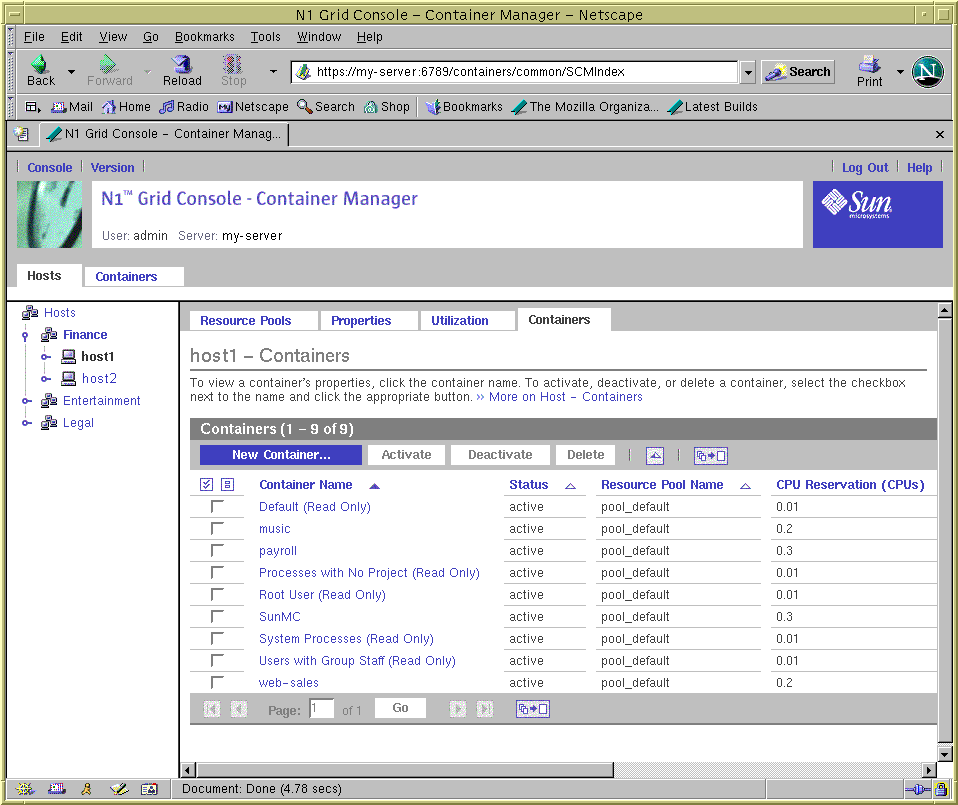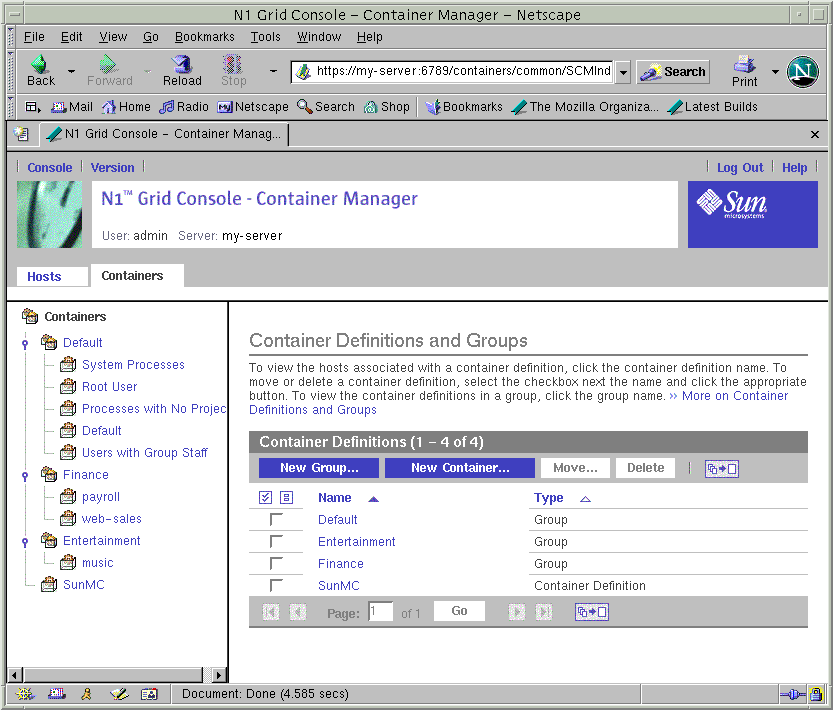Container Manager GUI
Standard Solaris software resource management command-line commands are not supported by the Container Manager software. You should manage the containers from the Container Manager graphical user interface (GUI). The GUI is launched from the Sun Web Console using a browser. The following browsers are supported:
-
Netscape NavigatorTM 4.7x, 6.2x, and 7.x on Solaris versions 8 and 9
-
Netscape Navigator 4.7x, 6.2x, and 7.x on Microsoft Windows (98/2000/XP)
-
MozillaTM
-
Internet Explorer 5.0 and higher (including 6.x) on Microsoft Windows (98/2000/XP)
To Launch the Container Manager GUI
-
If your UNIX user ID is not contained in the Sun Management Center esusers file, create this entry.
For instructions on how to create an entry, see “Setting Up Users” in Sun Management Center 3.5 Installation and Configuration Guide.
-
Launch a browser.
For a list of supported browsers, see Container Manager GUI.
-
Choose from the following URLs to go to the Sun Web Console:
-
To reach the Container Manager GUI directly after you log into Sun Web Console type:
https://host_machine_name:6789/containers
-
To reach the Console page after you log into Sun Web Console type:
https://host_machine_name:6789
The host machine name must be a Sun Management Center server.
The Sun Web Console login page appears. If the login page does not appear, you may need to restart Sun Web Console. For instructions, see To Restart Sun Web Console.
Figure 3–2 Sample: Sun Web Console Login Page

-
-
Log into the Sun Web Console using your UNIX user ID and password.
The Container Manager GUI appears. Two views are available from the Hosts and Containers tabs in the navigation window.
-
If you reach the Console page, select the N1 Grid Console - Container Manager 1.0 link to access the GUI.
To Restart Sun Web Console
If you are unable to access the Sun Web Console, use this command to restart it.
Container Manager GUI Tabs
The following table provides information about the tabs that appear in the right pane of Container Manager GUI. This table is presented alphabetically but the choice and order of tabs varies according to location in the GUI.
Table 3–1 Container Manager GUI Tabs|
Tab Name |
Contents |
Available From |
|---|---|---|
|
Alarm Thresholds |
Provides information about alarm threshold settings. |
Hosts view, Containers view |
|
Containers |
Provides information about the containers that are associated with a host. |
Hosts view, Containers view |
|
Hosts |
Provides information about the hosts associated with the selected container. |
Containers view |
|
Processes |
Provides information about the processes that are currently running in the container. |
Hosts view, Containers view |
|
Properties |
Provides information about the properties of the selected host, container definition, container, or resource pool. |
Hosts view, Containers view |
|
Resource Change Job |
Provides information about scheduled resource change jobs. You can also create new a new resource change job from this tab. |
Containers view |
|
Resource Pools |
Provides information about the resource pools on the selected host. |
Hosts view |
|
Utilization |
Provides information about a container's daily, weekly, or monthly resource utilization. Real-time utilization data is available for active containers. This tab is visible only if Performance Reporting Manager software is installed. |
Hosts view, Containers view |
Hosts View
The Hosts view organizes information from the host perspective. All agent machines that you are managing with the software appear in the navigation window. The resource pools available for each host are shown as well. You can also manage the containers associated to the host from this view.
All agent hosts that have the software installed are automatically discovered and added to the Hosts view. This view is accessed from the left tab in the navigation window. All agent hosts that are discovered are initially placed under a default group titled Hosts. You can further organize this view by creating new groups and moving the hosts to relevant groups.
Note –
Only those agent machines that are part of the Sun Management Center server context are loaded into the Hosts view. For more information about server context, see “Sun Management Center Architecture” in Sun Management Center 3.5 User's Guide.
The tabs and information available in the Hosts view is listed in Table 3–1.
Information about every container instance that is associated with a host is listed in the Containers table. This table is available from the Containers tab after selecting a host name in the navigation window. The Containers table provides information about each container, detailing one container per row. The Containers table provides the following data:
- Container Name
-
Name of the container.
- Status
-
State of the container: active and inactive
- Resource Pool Name
-
Resource pool to which the container is bound.
- CPU Reservation (CPUs)
-
Minimum CPU reservation set for the container.
- CPU Usage (CPUs)
-
Amount of CPU the container is using.
- Memory Cap (MB)
-
Maximum memory limit in megabytes.
- Memory Usage
-
Memory used by the container in megabytes.
Figure 3–3 Sample: Hosts View Showing the Container Table

Containers View
The Containers view organizes information from the container perspective. All container definitions and containers appear in the navigation window. Since container definitions can be used repeatedly to make new containers, you can readily access the definitions from this view, as well as perform other management tasks.
After installation and setup are complete, the Containers view automatically adds the Containers group as a default. Container definitions are managed from the Containers view.
The information available in the Containers view is listed in Table 3–1.
Figure 3–4 Sample: Containers View with Container Definitions Table Showing

Organizing Hosts and Containers With Groups
The Hosts view contains the default group Hosts. All hosts discovered after installation of the software are placed in this group. Likewise, the Containers view has a default group named Default in which all the default containers of a host are placed. You can create additional groups in each view for organizing the hosts and containers as you like.
To Create a Container Group or Host Group
-
If the Container Manager GUI is not already open, access it as described in To Launch the Container Manager GUI.
-
Select the appropriate view from the navigation window.
-
For a new container group, select the Containers view. The Container Definitions table is displayed in the right pane.
-
For a new host group, select the Hosts view. The Hosts and Groups table is displayed in the right pane.
-
-
Click the New Group button.
A dialog box appears.
-
Provide a name for the group, and click OK.
The name cannot exceed 32 characters.
The new group appears in the selected view.
To Move a Container or Host to a Different Group
-
If the Container Manager GUI is not already open, access it as described in To Launch the Container Manager GUI.
-
Select the appropriate view from the navigation window.
-
To move a container to a different group, select the Containers view. The Container Definitions table is displayed in the right pane.
-
To move a host to a different group, select the Hosts view. The Hosts and Groups table is displayed in the right pane.
-
-
To enable the Move button in the table, select the checkbox for the container or host that is to be moved.
-
In the right pane, click the Move button.
A dialog box appears listing the available groups.
-
Select the group to which the container or host is to be moved.
-
Click OK.
The container or host is moved to the selected group.
- © 2010, Oracle Corporation and/or its affiliates
